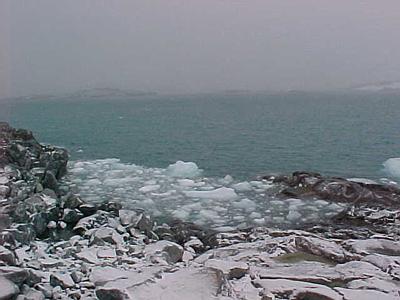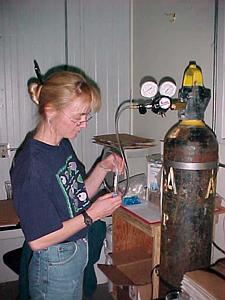23 March, 2000
Folin-Denis Assay: Part 1
Question 33: How much of the surface of the Southern Ocean gets covered by
ice in winter?
Today is our first day with snow!!! We have had windy days, overcast days,
beautifully sunny days, and sleeting rain days but this is the first with
snow. They are lovely big flakes but there are not too many of them. It
doesn't look as if it will accumulate much.
For more than a week Katrin and I have been running all the species of brown
algae (9) found here through the Folin-Denis assay. We will continue through
next week to get them done. The brown macroalgae are the only ones that have
large amounts of polyphenolic compounds, a special secondary metabolite that
is similar to tannins in terrestrial (land) plants. These compounds are
sensitive to light and oxygen so we collect the species we are going to work
on fresh that day and start processing the plants immediately. We work in the
semi-dark, wrap anything containing the samples in aluminum foil and store the
compounds under nitrogen to exclude air. Gaseous nitrogen is heavier than
air, so when we put it into a container it falls to the bottom and fills up
the space, pushing the lighter air up and out.
This assay (test) allows us to determine the concentration of polyphenols in
a sample of macroalgal tissue. Concentration is a measurement that tells us
how much of a substance there is in a given volume of (usually) liquid. It is
usually expressed in units that sound like "grams per liter," in other words,
weight per volume. These measurements are used everywhere. In your food, for
example. You can figure out the concentration of sugar in your soda very
easily. Just take the amount of sugar (in grams) from the nutritional
information panel and the total volume of the soda (probably in fluid ounces)
and make a fraction with the mass on top and volume on the bottom. You can
divide the numbers if you want to find out how many grams of sugar are in each
unit of volume but make sure you keep the units as a fraction. Concentrations
are not dependent on the amount of stuff you have, the concentration of sugar
in your Coca-Cola is the same whether you have one sip left or a
50-gallon-drum full of it.
For most of the species we are taking tissue samples from three different
areas of each plant: holdfast (where it was attached to a rock or other
object), middle of the blade, and end of the blade. We are looking for
differences in concentration between the different parts. Depending on how
these expensive-to-produce chemicals are distributed throughout the plant, we
can draw conclusions about what the chemical is used for, which parts are most
important to the plant, and what that means for its life strategy. We use
several plants of each species to make sure that any differences we see are
representative of the species rather than the individual (replicates again).
Continued tomorrow...
Answer 32: Chinstrap penguins can dive to about 100 meters, but most of the
time they go to 45 meters or even less in their search for krill. Adelies
also can dive to about 100 meters. Gentoos dive deeper, to 150 meters.
Emperor penguins dive deepest, to depths of 265 meters (and possibly more) in
search of squid, their favorite food.

Arthur Harbor off Gamage Point.

Katrin Iken covering sample with nitrogen.

Contact the TEA in the field at
.
If you cannot connect through your browser, copy the
TEA's e-mail address in the "To:" line of
your favorite e-mail package.
|
